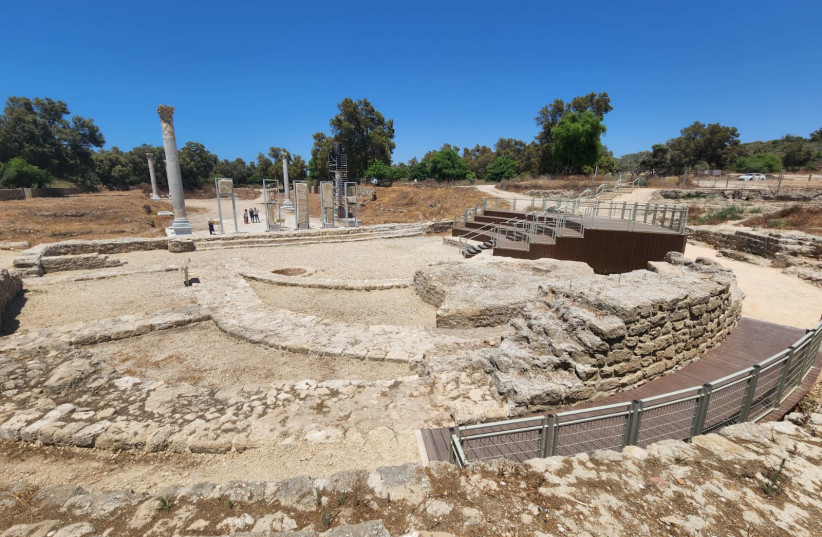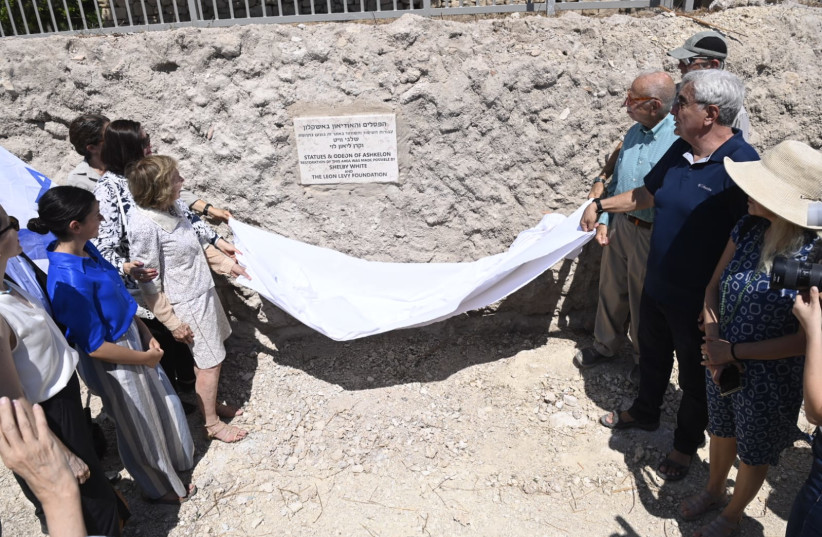For almost 100 years since they were first excavated at Tel Ashkelon, the magnificent marble statues of Roman gods and goddess languished virtually neglected in an excavation pit.
Now, as part of the continued conservation and development at the Tel Ashkelon National Park archaeological site, these five massive Roman statues have been raised from their grave and placed on display in the park.
“They had been left and ignored for a long time. We rescued them and cleaned them and put them in a very nice way to present to visitors.”
Zeev Margalit, director of the conservation and development department of the INPA
The marble figures include two almost complete statues and three partial statues. In one, the Greek goddess of victory – winged Nike – is depicted standing on the globe, which is carried on the shoulders of Atlas. One hand of the goddess holds a laurel wreath, the symbol of victory.
Another statue depicts Isis, the Egyptian goddess of fertility as Tyche, often depicted as a city’s goddess of fortune. At the time many religions adopted beliefs and modified their own religious practices as they came into contact with other religions. Both Greek and Roman religious beliefs were influenced by religions of the east, including the Egyptian cult of Isis.

The Tel Ashkelon National Park has been undergoing a large-scale renovation project, funded by the Israel Nature and Parks Authority (INPA), the Ashkelon Municipality and the Leon Levy Foundation. Conservation and restoration work has been carried out on the statues as well as on a large Roman basilica and odeon—a small covered theater of sorts.
Following a year of work, the odeon and the statues were officially inaugurated on June 27 by founding trustee of the Leon Levy Foundation, Shelby White. Reconstructed tribunals and an orchestra platform were built in the odeon.
Restoration of ancient relics
The statues, whose beauty once graced the basilica, stand between the southern part of the basilica and the odeon, using special frames.
“They had been left and ignored for a long time. We rescued them and cleaned them and put them in a very nice way to present to visitors,” said architect Zeev Margalit, director of the INPA Conservation and Development Department.
“They were ornamental and decorated the basilica. It is now a very impressive feeling to see the statues standing once again, though some are broken, and you can understand the quality of the work and the high level of skill used to sculpt the marble.”
Located on the main trade route from Egypt to the North, the city of Ashkelon was a very important commercial center for trade. It has a history that stretches back 5,000 years to the Early Canaanite period, through to the Philistines for whom it constituted one of their five cities, mentioned in the Bible, on to the Hellenistic and Roman periods and through to Crusader times.
Biblical origins
In Judges 1:18 the bible recounts how Ashkelon, along with Gaza and Ekron, briefly fell into the hands of the tribe of Judah, but by 2 Samuel 1:20, the Philistines had already regained control of the city.

The city flourished during Roman times. King Herod built the grandest of basilicas, which were more like community centers than temples. Some sources even say that Herod’s family hailed from Ashkelon.
The first excavations of the ancient city were led by the famous adventurer and traveler Lady Hester Stanhope in 1815. The niece of British prime minister William Pitt, Stanhope shirked societal conventions of the time and came seeking treasures in the Middle East, making Lebanon her home base after she found nothing that glittered in Ashkelon.
The first scientific excavations of the site were held by John Garstang of the British Palestine Exploration Fund from 1920-1922. During these Mandate-era excavations, Herod’s basilica, the odeon and remains of the statues were discovered. Garstang created an open-air museum for his finds, but with time the area was abandoned and neglected, noted Margalit.
More recent excavations in 2008-2012 and 2016-2018 fully uncovered the basilica, which was destroyed in an earthquake in 363 CE. They revealed more than 200 marble artifacts, including monumental columns and capitals from the basilica.
Restoration and conservation work continues on the basilica complex and is expected to be completed by mid-2023, said Margalit, and will include new and accessible paths around the heritage and landscape sites of the park.
